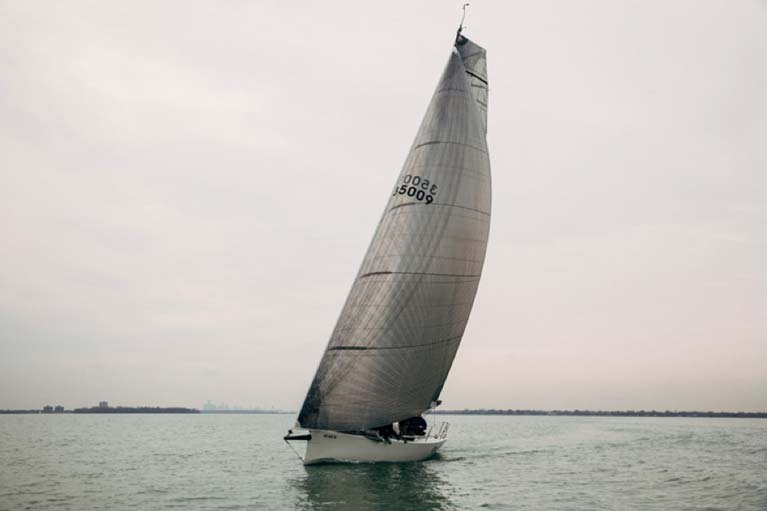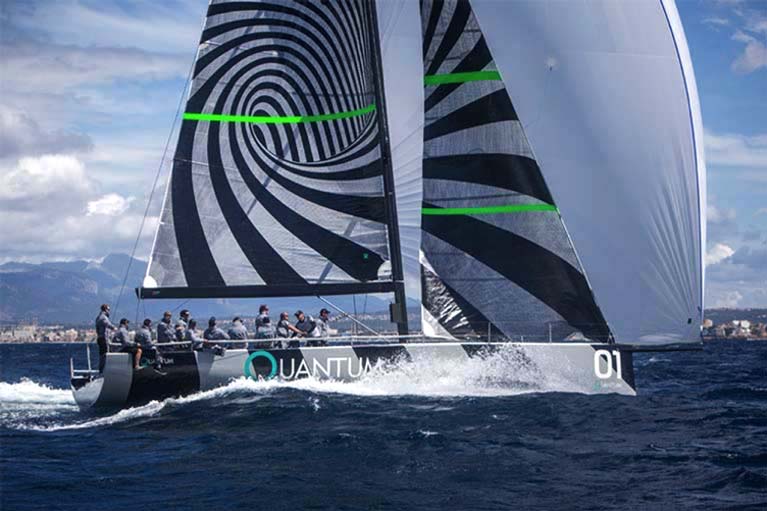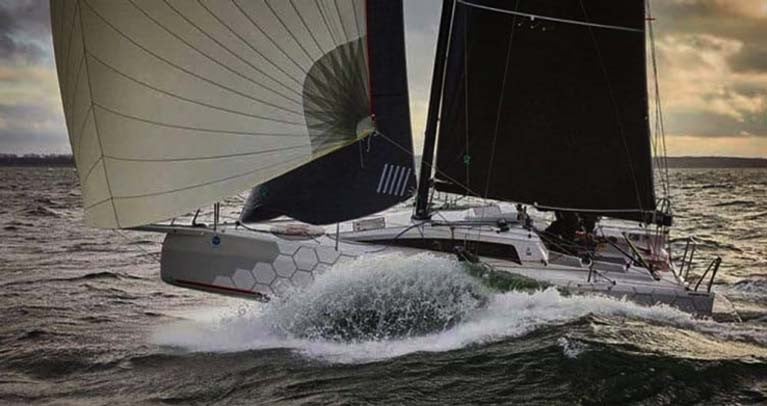Mark Mansfield, Quantum Sailmakers Ireland agent and professional sailor, outlines what downwind sails should be available to owners who want to compete at a top-level offshore.
Having competed in the last two Round Ireland Races (on the Euro Car Parks/J109 in 2016 and the JPK 10.8 Rockabill VI in 2018). and with the next Round Ireland being just a few months away, I will go through the options and the must-have downwind sails which owners who want to be in contention, should have.
In Ireland, offshore racing is on the increase, as is shorthanded racing. The ISORA series is going from strength to strength, races like the Dun Laoghaire to Dingle and Round Ireland Races are increasing each year. In 2020, not only do we have Round Ireland, but we also have the Morgan Cup race which finishes in Cork and the 'Kingstown to Queenstown' Race also finishing in Cork. The latter two are also being used as races to get the fleets to the Cork 300 spectacular in July.
Added to this, coastal racing at regattas such as ICRAs and Dun Laoghaire Regatta is gaining a lot of support, which in effect is like a mini offshore. The sails you carry for inshore races are often quite different to the sails you will need for long offwind legs. I will outline below the downwind sail inventory that each competitive boat might look to carry.
Asymmetric/Symmetric
There is a difference between the sails that need to be carried for each option. The Asymmetric option may allow fewer sails, as all sails are Asymmetrical. With a symmetrical configuration, you will ideally need your running sails (maybe an S2 and an S4), but also you will need reaching sails such as a Code 0 and an A3 (reaching Asymmetrical) preferably set on a small bowsprit.
So what sails do both asymmetrically configured boats (pole) and symmetrically configured boats need? They are:
Code 0
Up to about five years ago, there were few code 0s on boats. However, with all new boats now generally using non-overlapping configurations, there is a big gap when reaching from a sheeted out headsail, to a Code 0. Take an example of a 35 footer with a non-overlapping 30 sq. metre headsail. Generally, such a boat, if it uses a pole (symmetric), will have a circa. 100 sq. metre max sized spinnaker. If it was an asymmetric boat, it would have about a 110 sq. metre asymmetrical spinnaker on a bowsprit.
 Quantum Code 0 cableless slipping along in light airs
Quantum Code 0 cableless slipping along in light airs
In each of these cases, If you are tight reaching in light airs, say TWA of 60/80 degrees, It will be too tight to get an A sail working. If you don’t have a Code 0. Then you end up with an outboarded sheeted jib of 30 sq. metres. However a similar boat next to you, which has a Code 0, can set this and because it is rated as a spinnaker, it likely will be about 75 sq. metres, approx. 2.5 times the size of the Jib. The new Cableless Code 0’s from Quantum, can, in light airs, get right up about 55 degrees TWA, as the excess cloth in the sail can be minimised by tightening the Halyard which compresses the full part of the sail. In IRC the mid girths for a Code 0 cannot be less than 75%, so getting rid of fullness in the middle is the challenge. The cableless Code 0 does this more effectively than a Cabled Code 0.
When the breeze gets broader a bit, then the halyard can be eased and the excess cloth comes free and actually can project to windward.
In strong airs, the code 0 can also be used as a small blast reaching spinnaker, in conditions too windy for a normal A3/A5 spinnaker. The Code 0 is a must-have sail nowadays, particularly for non-overlapping boats. Even with overlapping boats—take the 35-footer mentioned above, if she had an overlapping 40 sq. metre headsail, the code 0 would still nearly be twice the size.
A3/A5 Asymmetric Spinnaker
Whether your boat is set up with a Pole(symmetric) or only a sprit(asymmetric), if you have a long reaching leg, You do not want to be carrying either an S4(heavy Running Symmetrical Spinnaker) or an A4(heavy running Asymmetrical spinnaker). The reason for this is they are designed to be very deep in the head and midsections, to run deep and fast.
For beam reaching, or even reaching with the wind aft of the beam in stronger conditions, a flatter, slightly smaller Asymmetric spinnaker, is what is needed. This will lessen broaching, and will just be quicker. In the case again of the 35 footer with a full-size symmetrical spinnaker of 100 sq. metres, she would likely carry an A3/A5 of about 90 sq. metres. Even if this 35 footer, was sailing with full Asymmetrical configuration, her A3/A5 would still likely be around the same size.
If you were able to carry both an A3 and an A5, then the sizing might be more like 95 sq. metres for the A3 and 80 sq. meres for the A5. However most boats have a max spinnaker number that they can carry, so a Hybrid A3/A5 makes sense. A 90 sq. metre A3/A5 fits nicely then for reaching with the 75Sq metre Code 0, and covers all the Requirements when reaching.
Running Spinnakers
Asymmetric set up
 Quantum TP52 Power reaching with asymmetric chute
Quantum TP52 Power reaching with asymmetric chute
If you are purely an asymmetric boat with a sprit (like a J109) and you only want to carry 3 spinnakers, then you have just one spinnaker left, if you have the A3 and the Code 0.
This then has to be the A2 Running all-round spinnaker. It will get close-ish to the wind in light airs but is really designed to be sailed deep, broad-reaching and running. The only downside with this is if the breeze gets to 20kts plus, you run the risk that the A2 will blow, and be unrepairable. Then you are just left with the A3/A5 as your biggest spinnakers.
A much better option is to carry four spinnakers, take An A4 heavy runner and accept the approx. 1 point difference in rating. If it did come to pass that the A2 blew, at least the A4 is approx. the same size, although a heavier cloth and maybe a little narrower in the head.
Symmetric set up
This is quite similar to the Asymmetric setup, with one difference, if you decide to only carry 3 spinnakers, then the S2 is likely the one you will go with. However, If this blows, you have no Symmetric spinnakers to use when running. For an Asymmetrical boat, at least they still have a long sprit to carry the A3/A5 when running. With a Symmetrical setup boat, the sprit is very short and the A3/A5 is very inefficient when running with a short sprit. So for this setup, I would always suggest an S4, in addition to an S2 be carried, and take the one-point penalty in rating.
However, the weather forecast will also be taken into account. If it were forecast to be light for the whole race, maybe it is worth the risk to just go with one running spinnaker. If, however, it is scheduled to be strong at a time when going downwind, then it would be very risky just to carry one running spinnaker.
Conclusion
My thoughts then on which spinnakers should be carried offshore, bearing in mind the above paragraphs, would be,
- Symmetric set up: S2 , S4, A3/A5, Code 0.
- Asymmetric Set up: A2, A3/A5, Code 0. If windy forecast, also take an A4.
There are other sail options downwind, that involve sails rated as headsails—like staysails, flying Headsails, and I will touch on these in a later article.
Quantum Sails Ireland would be delighted to discuss downwind or upwind sail options with any client or potential client, and give our thoughts.
Download the Quantum brochure below
Mark Mansfield [email protected] ph 087 250 6838
Yannick Lemonnier-- [email protected] Tel: 087 628 9854


























































